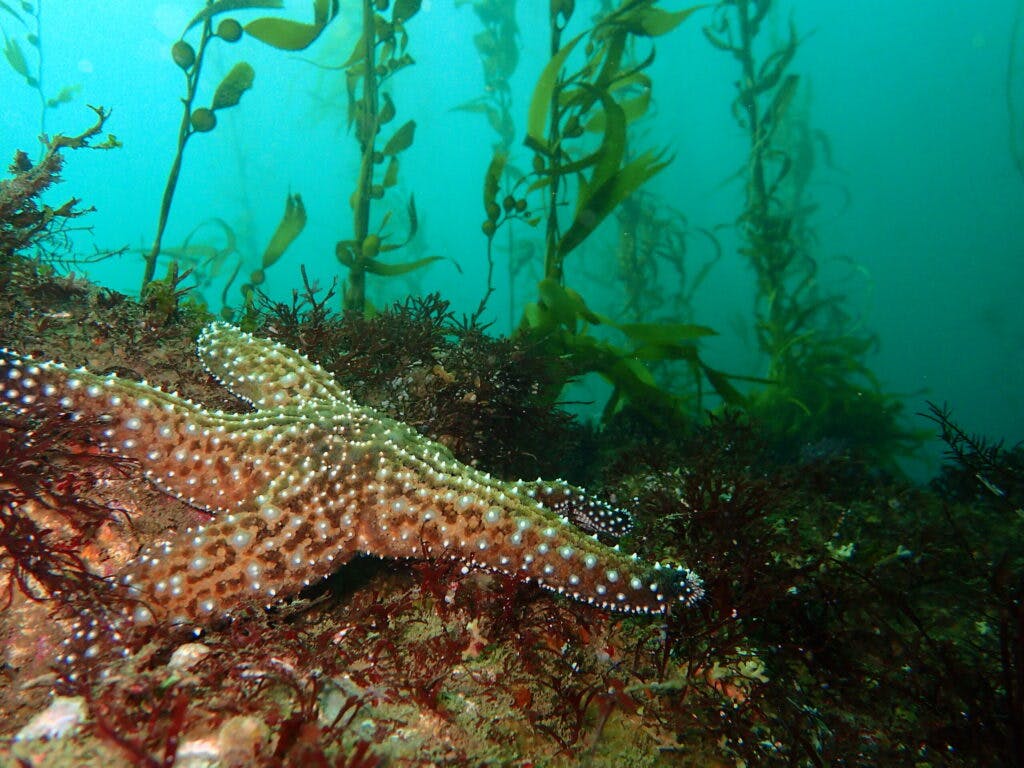- English
- Spanish
- Korean
- Filipino
- Armenian
- Chinese (Simplified)
Rocky Reefs
Prev
Coastal Wetlands
Next
Soft Bottom
Habitat Overview
In Santa Monica Bay, Rocky Reefs are primarily located along the coast off of Palos Verdes and Malibu where mountains essentially extend into the nearshore ocean. These rocky reefs are jumbles of rock. Formed by expanses of bedrock, 30x30x30 foot monoliths, (10 meters), and large fields of boulders, cobbles, and gravels. Collectively these rocky reefs extend for miles along the coast, most being shallower than 100 feet, (30 meters) in depth. Notable exceptions to this exist near Rocky Point in Palos Verdes and Point Dume in Malibu. These shallow depths allow for ample light to penetrate the water providing the energy for algae and kelps to grow.
Giant kelp forests can dominate this Rocky Reef habitat extending from the rocks all the way to the surface. The physical presence of these kelp forests and all the crevices between the rocks provide a rocky reef/kelp forest habitat that is one of the most biologically diverse and productive habitats on earth. The giant kelp grows very quickly when there is ample light and nutrients. Thousands of these kelps growing in a forest together can slow water currents, impact small waves, increase dissolved oxygen, and support hundreds of marine species. This diverse and prolific assemblage of algae, fish, and invertebrates makes these rocky reef/kelp forests a favorite spot for recreational and commercial fisheries, SCUBA diving, and snorkeling. For surfers having a kelp canopy on the surface helps keep the waves glassy all day.
Another form of Rocky Reef habitat exists in Santa Monica Bay comprised of the rocks used to build breakwaters, jetties, and offshore fishing reefs. Much of this rock was sourced from Catalina Island and barged over to create these features. The breakwaters off the Santa Monica Pier, Marina Del Rey, and King Harbor are the largest and may provide similar habitat value to naturally formed rocky reefs.
Status
| Indicator | Score | Confidence |
|---|---|---|
| Habitat Extent | Moderate | |
| Habitat Vulnerability | Moderate, Moderate | |
| Structure & Ecological Disturbance | Moderate, Moderate | |
| Biological Response | Not Scored |
Per the Rocky Reefs habitat's 2015 condition, see below for condition details.
Why Is a Healthy Rocky Reef Habitat Important?
Although the area of rocky reef habitat is relatively limited compared to other habitats in the Bay, they support some of the Bay’s most diverse and productive biological communities, help alleviate the effects of climate change, and are of high socioeconomic value.
Kelp Forests and Marine Life
The abundance and diversity of marine life are especially apparent in the giant kelp forests (Macrocystis pyrifera) that cover some rocky reefs.
The kelp beds provide protection and habitat for more than seven hundred species of fish and invertebrates, including a few protected species, such as the green abalone (Haliotis fulgens), Giant Sea Bass (Stereolepis gigas) and endangered white abalone (H. sorenseni).
Commercial Fishing and Diving
Because of the diverse and abundant assemblage of organisms, rocky reefs in the Bay are important sites for commercial and recreational diving and fishing. Some of the key commercial and recreational species in this habitat are California spiny lobsters (Panulirus interruptus), Kelp Bass (Paralabrax clathratus), and White Seabass (Atractoscion nobilis).
Climate Change
Growing scientific research describes the value of kelp forests to assist in mitigating climate change through mechanisms such as carbon sequestration, reduction in currents and wave energy, and localized elevation of pH, which may provide a refuge for ocean acidification. When the kelp drifts away from the rocky reef, it provides habitat and nutrients to many other coastal systems of interest to SMBNEP and other coastal resource managers.
Primary Challenges
Water Conditions and Quality
Giant kelp tends to grow and die along with changing oceanographic conditions and the frequency and intensity of storm events that are a part of the natural cycle of kelp. It grows better in colder water with plenty of upwelled nutrients. The energy from waves, often associated with winter storms, can rip entire kelp plants from the rocky substrate.
It is also susceptible to poor water quality in the form of suspended solids and shifts toward purple sea urchin (Strongylocentrotus purpuratus)-dominated systems. Rocky reefs off Palos Verdes are also susceptible to landslides that may bury rocky substrate for decades, contributing to habitat loss along this stretch of Santa Monica Bay.
Unfortunately, sedimentation and landslides historically and currently challenge the integrity of this ecosystem. Landslides bury reefs and their sedimentation impacts surrounding reefs by increasing turbidity, decreasing light and scouring reefs.
2015 Habitat Condition
Read more about the rocky reefs habitat conditions through our data and research published in the 2015 State of the Bay Report
Taking Action
Learn more about the work being done by SMBNEP partners and The Bay Foundation to protect and improve the Bay’s soft bottom habitats.
Learn More
The Marine Protected Areas were established as part of a statewide network in Santa Monica Bay along the Palos Verdes Peninsula and Malibu in 2012. In the most recent assessment of these reserves, the south coast reserves and in specific those in the bay have exhibited the most positive response to protection in the state.
